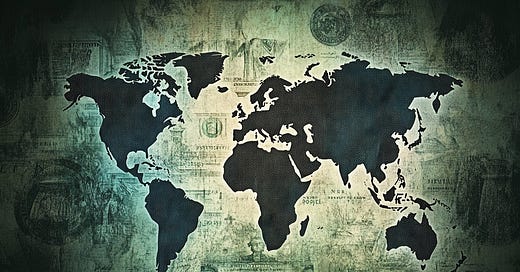A Crisis of Confidence in the Dollar Threatens Global Financial Stability
A rise in US Treasury yields would immediately feed through into other countries’ borrowing costs, tightening global financial conditions
President Nixon’s policies — suspending dollar convertibility in 1971, imposing import tariffs, and introducing wage and price controls — triggered a period of deep global economic instability, with lasting negative consequences for Europe
Since the so-called “Liberation Day” of April 2, economic discussions have centred on the damage caused by US tariffs and how to respond. In reality, the consequences for the global economy are far more profound.
At the root of the issue lies the high public debt burden carried by both advanced and emerging economies — debt that was accumulated over recent years amid ultra-low interest rates and growth sustained by globalisation.
The most prominent example is US federal debt, which has soared over the past two decades from 60 per cent of GDP in 2005 to 120 per cent at the end of last year, driven by persistent fiscal deficits averaging more than 6 per cent of GDP annually.
These figures have long been known, but they have not alarmed international investors, who have continued to place their trust in the dollar — and, more specifically, in US Treasuries — as safe-haven assets.
This confidence has been underpinned by certain key features of the American economy: entrepreneurial dynamism, the openness and liquidity of its financial markets, the independence of the Federal Reserve, and a longstanding commitment to defending the dollar’s external value. That commitment was famously summarised by Robert Rubin, Treasury Secretary under President Bill Clinton: “A strong dollar is in the interest of the United States” — a line that deterred speculative behaviour for decades.
Now, policies enacted or proposed by the new Trump administration are beginning to erode that trust — not only internationally, but also within the United States itself. Three factors stand out.
The first concerns the effect of tariffs on US growth and inflation, at least in the short to medium term. On one hand, slower growth reduces tax revenues and widens the fiscal deficit. On the other, higher prices keep interest rates on government debt elevated, compounding the debt-servicing burden.
Without stronger economic growth, restoring balance to US public finances becomes significantly harder — not only because federal spending is already relatively low (12 percentage points of GDP below that of Europe), but also because past tax cuts are seen as politically untouchable. The Trump administration, for its part, has signalled its intention to introduce further tax reductions.
The second reason for waning confidence is the administration’s declared intent to abandon the strong-dollar policy, which it blames for the US trade deficit and the hollowing out of domestic industry.
This reversal sends a clear signal to investors — especially foreign ones — encouraging them to sell off US government bonds. That, in turn, drives down the value of the dollar and pushes long-term interest rates higher, as seen in early April.
The third factor — so far only floated — is the idea of penalising foreign holders of US debt, whether by extending maturities or by imposing controls on capital inflows. Such proposals, recently revived by Michael Pettis in an article for the Financial Times, would only deepen international unease.
A collapse in confidence in US Treasuries could unleash widespread disruption across the international financial system.
Higher US rates would be transmitted almost instantly to other countries’ debt markets, tightening financial conditions globally and exacerbating already fragile debt dynamics.
Market volatility would spike — particularly in currency markets — inflicting additional costs on the real economy. Instability would further undermine investor trust, triggering knock-on effects that could reverberate through financial institutions and national economies alike, echoing the chain reaction seen during the 2008 crisis sparked by the collapse of Lehman Brothers.
Given the dollar’s central role in the global financial system, a loss of confidence in the US currency would have systemic repercussions — consequences that those at the eye of the storm may not yet fully grasp.
Economic historians will recall President Richard Nixon’s policies of the early 1970s: suspending dollar convertibility in 1971, levying import tariffs, and implementing price and wage controls.
Those decisions ushered in an era of profound global instability, hitting also Europe particularly hard. It took over a decade to restore order — a task only achieved through the draconian monetary tightening led by the Federal Reserve.
Of course, the conditions at that time differed in key respects. China was still a closed economy — and US public debt stood at just over 30 per cent of GDP.
A first version of this article was published in the Italian daily Il Foglio
Lorenzo Bini Smaghi
Lorenzo Bini Smaghi holds a degree in Economic Sciences from the Université Catholique de Louvain (Belgium) and a Ph.D in Economic Sciences from the University of Chicago. He has been Chairman of the Board of Directors of Societe Generale since 2015. He is an IEP@BU non-resident fellow
The IEP@BU Mission
Founded by Bocconi University and Institute Javotte Bocconi, the Institute for European Policymaking @ Bocconi University combines the analytic rigor of a research institute, the policy impact of a think tank, and the facts-based effort of raising public opinion’s awareness about Europe through outreach activities. The Institute, fully interdisciplinary, intends to address the multi-fold obstacles that usually stand between the design of appropriate policies and their adoption, with particular attention to consensus building and effective enforcement.
The Institute’s mission is to conduct, debate, and disseminate high-quality research on the major policy issues facing Europe, and the EU in particular, its Member States and its citizens, in a rapidly changing world.
It is independent of any business or political influence.
The IEP@BU Management Council
Catherine De Vries, IEP@BU President
Daniel Gros, IEP@BU Director
Sylvie Goulard, IEP@BU vice-President, Professor of Practice in Global affairs at SDA Bocconi School of Management
Silvia Colombo, IEP@BU Deputy Director
Carlo Altomonte, Associate Professor at Bocconi University and Associate Dean for Stakeholder Engagement Programs at SDA Bocconi School of Management
Valentina Bosetti, professor of Environmental and Climate Change Economics at Bocconi University
Elena Carletti, Dean for Research and Professor of Finance at Bocconi University
Eleanor Spaventa, Professor of European Union Law at Bocconi Law School








Will a single currency succeed the dollar? Or will we enter a multipolar regime, a trio of global anchors? The euro is eager. The renminbi is maturing. And gold, as ever, offers protection and stands watch; silent, neutral, and increasingly expensive.
Recent financial tensions unveil on an old idea in macroeconomics known as the "impossible trinity": no country can simultaneously have a fixed exchange rate, free movement of capital, and full control over its own monetary policy. At best, you can pick two. The US has long chosen to let capital flow freely and to give its central bank, the Federal Reserve, full independence. In doing so, it allowed the dollar to float, meaning its value is set by global markets. The U.S. is running larger and larger deficits, borrowing more to fund its growing obligations. A weaker dollar would help rebalance its economy. But a weaker dollar also means giving up some of its influence.
https://open.substack.com/pub/marketszoon/p/gold-the-one-who-waits?r=58uzcq&utm_medium=ios